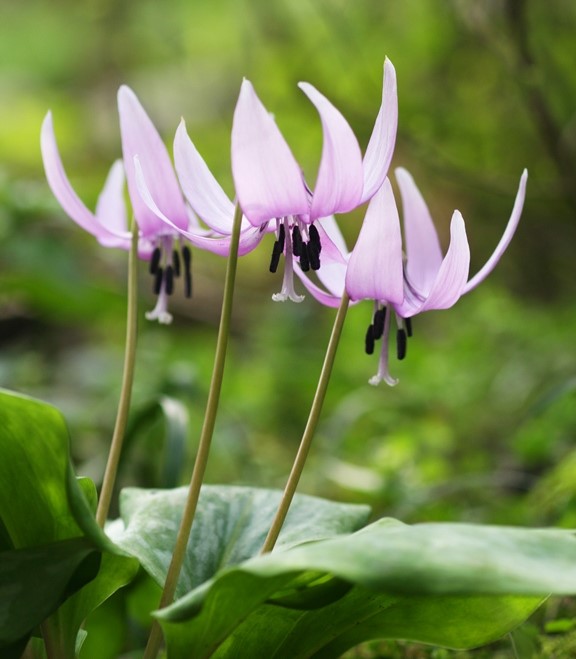歌碑14「かたかごの花」-勝興寺 右側後方Monument No.14 “Dogtooth Violets” -Back yard of Shōkōji Temple
2022年08月25日

かたかごの花を折り取りつつ、群生するその花とそのそばで水を汲む愛らしい乙女たちの姿を写し取った絵画的な歌である。
This poem depicts lovely maidens gathering water from a well amid a field of dogtooth violets.
![万葉歌めぐりの旅[Man'yōshū Literary Pilgrimage]](https://www.manreki.com/manyo-songs/images/common/pic_logo.svg)
2022年08月25日

かたかごの花を折り取りつつ、群生するその花とそのそばで水を汲む愛らしい乙女たちの姿を写し取った絵画的な歌である。
This poem depicts lovely maidens gathering water from a well amid a field of dogtooth violets.
katakago no hana o yojioru uta isshu
堅香子草の花を攀ぢ折る歌一首
mononofu no
もののふの
yaso otomera ga
八十娘子らが
kumi magau
汲みまがふ
terai no ue no
寺井の上の
katakago no hana
堅香子の花
Ōtomo no Yakamochi
(Vol.19, No. 4143)
大伴家持
(巻19・4143)
たくさんの乙女たちが
入り乱れて水を汲む、
その寺の井戸のそばに咲く
堅香子の花よ。
So many lovely maidens
gathering to draw water,
and around the temple well
dogtooth violets
blossoming here and there.
攀折堅香子草花歌一首
物部乃 八十■※1嬬等之 ■※2乱 寺井之於乃 堅香子之花
※1 女偏に「感」
※2 手偏に「悒」のつくり部分
大伴家持
物 部 乃
八十1嬬等之
2乱
寺井之於乃
堅香子之花
孝書
※1 女偏に「感」
※2 手偏に「悒」のつくり部分
揮毫 : 犬養孝(大阪大学名誉教授)
Calligraphy by Takashi INUKAI(Professor Emeritus, Osaka University)
建設者 : 大伴家持卿顕彰会
Constructor : Sir Ōtomo no Yakamochi Honour Society
1987年建立
Erected in 1987
解説
Commentary
かたかごの花
Dogtooth Violets
『万葉集』の4143番の歌。『万葉集』は、7世紀前半から8世紀後半にかけての約130年間の歌を収めた現存日本最古の歌集で、4500首余りの歌が収められている。この歌の作者は大伴家持(718?~785)、『万葉集』でも最も多くの歌を残す歌人である。
巻19冒頭には天平勝宝二年(750)三月一日~三日朝にかけて作られた十二首の歌が並ぶ。これらは「越中秀吟」と呼ばれ、家持の越中時代の歌の中でもとりわけ評価が高い。
この歌はその越中秀吟の第五首目。かたかごの花を折り取りつつ、群生するその花とそのそばで水を汲む愛らしい乙女たちの姿を写し取った絵画的な歌である。かたかごを詠う歌は『万葉集』中この一例のみで、家持独自の美意識がよく表れた歌と言える。
高岡市の勝興寺右側後方、伏木小学校校庭、高岡駅前広場(家持像台座)に歌碑が立つ。
(解説 ピーター・J・マクミラン)
This is poem number 4143 of the Man’yōshū, the oldest existing collection of poetry in Japan. The Man’yōshū consists of over 4,500 poems and was compiled over a period of around 130 years, from the first part of the 7th century to the latter part of the 8th century. The author of this poem is Ōtomo no Yakamochi.
This poem depicts lovely maidens gathering water from a well amid a field of dogtooth violets. It was composed by the poet while picking these flowers and is the only poem in the Man’yōshū that mentions dogtooth violets. The way in which the young ladies scattered in a group are overlapping with the flowers scattered here and there conveys Yakamochi’s exquisite sense of beauty.
Book 19 of the Man’yōshū begins with twelve poems composed between the 1st and the 3rd day of the third month, 750. These poems are known as “Etchū Shūgin” (Splendid Poems of Etchū) and are some of the most highly regarded poems from Yakamochi’s time in Etchū. This is the fifth poem in that series.
This waka poem stone monument stands at various places around Takaoka City, including in front of Takaoka Station.
(English Translation and Commentary by Peter Macmillan)